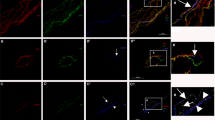Abstract
Stimulation by norepinephrine in physiological concentration was used on the dorsal skin of the Argentine tree-frog Phyllomedusa hypochondrialis azurea to trigger contraction of myoepithelial cells encircling the serous glands and provoke secretory release. This hylid species possesses two kinds of serous cutaneous glands, producing secretory granules or vesicles (type Ia and Ib serous units, respectively), along with serous-derived glands which synthesise lipids and store them in complex aggregates (type II units). Structural and ultrastructural observations on myoepithelia, secretory units and gland products collected in saline after discharge, revealed consistent but different responses in the three types investigated. Type Ia glands reacted intensely to treatment, with both contractile and secretory responses, type Ib glands were only mildly affected in their myoepithelia and glands of type II were not affected at all. According to data available in the literature, these findings suggest that: (a) the dense (type Ia) granules are expelled as a phasic response through bulk (holocrine) discharge, (b) the secretory (type Ib) vesicles are released as a tonic response through a merocrine mechanism and (c) lipid (type II) aggregates are exuded as a secretory component of a complex behavioural response which tends to reduce transcutaneous water loss. Furthermore, these findings indicate that the use of pharmacological modulation of myoepithelial activity allows selective collection of skin products in species characterised by serous gland polymorphism.
Similar content being viewed by others
Author information
Authors and Affiliations
Additional information
Electronic Publication
Rights and permissions
About this article
Cite this article
Nosi, D., Terreni, A., Alvarez, B. et al. Serous gland polymorphism in the skin of Phyllomedusa hypochondrialis azurea (Anura, Hylidae): response by different gland types to norepinephrine stimulation. Zoomorphology 121, 139–148 (2002). https://doi.org/10.1007/s004350100051
Accepted:
Published:
Issue Date:
DOI: https://doi.org/10.1007/s004350100051




